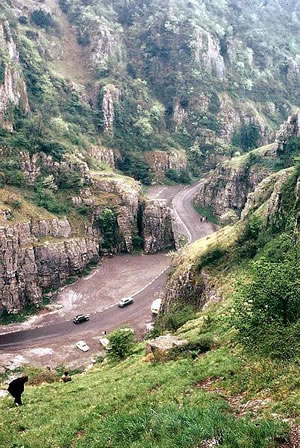Cheddar Gorge is a limestone gorge in southwest England.
It lies deep in the southern escarpment of the Mendip Hills, which stretch across the north of the county of Somerset for about 48 km (30 mi).
The oldest known complete human skeleton, known as Cheddar Man, was discovered in Cheddar Gorge
 At their highest, the limestone hills reach 315m (1,066ft). The craggy cliffs of the gorge rise more than 122m (400ft) above the winding road below. In places, bare, rugged limestone shows through the profuse vegetation, but elsewhere the cliffs are shrouded in greenery.
At their highest, the limestone hills reach 315m (1,066ft). The craggy cliffs of the gorge rise more than 122m (400ft) above the winding road below. In places, bare, rugged limestone shows through the profuse vegetation, but elsewhere the cliffs are shrouded in greenery.
From the hilltop, the gorge winds down for about 3.2km (2mi), twisting and turning before reaching the town of Cheddar at its base.
Formation of Cheddar Gorge
At the beginning of the 19th century, scientists believed that the gorge was been created by a violent earthquake that ripped the Mendips apart in a single colossal upheaval.
By the close of the century, however, this explanation had been replaced by two others. According to one theory, continuous rainfall had percolated down through the limestone and formed an underground river that etched away, and then flowed through, myriad caves and passages. As the percolation continued, the river grew larger and the rocky roof above it became thinner. Eventually, the roof collapsed, as at Verdon Gorge in the southwest of France, opening the enormous cave to the sky.
The more generally accepted theory comes from the fact that the gorge resembles a dry river valley. During the ice ages of the past million years, when all but the surface of the land was permanently frozen, a river cascaded over the bare limestone and gradually carved its way to the plain below. The river dissolved the underlying limestone, creating caves, sinkholes and passages, before it dwindled to a stream and flowed underground.
Limestone Caves
1837, local miller George Cox was quarrying limestone beside the mill when he discovered a huge hole in the rock. Upon entering, Cox discovered a huge a cavern adorned with stalactites and stalagmites.
Then entrance cavern to this series of caves contains stalagmites stained either red from iron oxide or blue-black from manganese.
In another cave, a triple stalactite named the Peal of Bells emits a musical note when lightly tapped.
At the deepest point of this system of caves, which runs for 90m (295ft), lies a deep sinkhole. The water in this hole rises and falls throughout the year depending on the water level of the underground stream that emerges at the mouth of the gorge.
The success of Cox's cave system inspired other Cheddar residents to search for hidden natural wonders.
In 1890, Richard Gough found another system of caverns, which penetrates 1,143m (3,750ft) into the Mendip hillside.
During excavations in 1903, a man's skeleton was discovered in the entrance cave of Gough's cave system. Nicknamed the Cheddar Man, this skeleton dates back to around 10,000 BC and indicates that the caves were inhabited during the early Stone Age.
Deeper within the cave system, where the temperature remains a constant 11 degrees Celsius (12 degrees Fahrenheit), Gough found natural formations that resembled frozen waterfalls, rivers of marble, pillared halls and cathedral vault deeper within the cave system. Many of these formations were tinted green from copper carbonate, grey from lead or red from iron oxide.
Gough named a large, airy chamber, about 21m (70ft) high, St Paul's, after the Cathedral in London. He called a collection of white pillars around a still pool of water Aladdin's Cave.